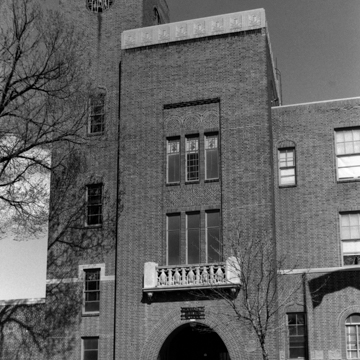A playful fusion of sculpture and architecture sets this Art Deco elementary school apart from other public schools of its era. The general massing of the flat-roofed building looks modernist in its geometric simplicity. An abundance of high-quality, handcrafted exterior details further distinguishes the structure. The school is composed of a three-story classroom block with a taller entrance tower at the north end and a one-story auditorium wing added in 1961. Brickwork laid in a modified Flemish bond pattern imparts texture and richness to the wall surfaces of the N. 16th Street side classroom wing. Set into this brick background, and mostly on the entrance tower, is an extraordinary program of handcrafted ornament. Alongside the stoop outside the dramatic round-arched entrance, the low stone retaining walls are highlighted in bas-reliefs with a small menagerie. At the first-floor windowsill level, terra-cotta panels depict characters from children’s stories and nursery rhymes. Above the school entrance two corbels shaped like bears’ heads support a balustrade of carved limestone penguins. Some of the school’s interior spaces also contain handcrafted ornamental features that continue the zoo and storybook theme.
You are here
Emanuel Philipp School
If SAH Archipedia has been useful to you, please consider supporting it.
SAH Archipedia tells the story of the United States through its buildings, landscapes, and cities. This freely available resource empowers the public with authoritative knowledge that deepens their understanding and appreciation of the built environment. But the Society of Architectural Historians, which created SAH Archipedia with University of Virginia Press, needs your support to maintain the high-caliber research, writing, photography, cartography, editing, design, and programming that make SAH Archipedia a trusted online resource available to all who value the history of place, heritage tourism, and learning.















